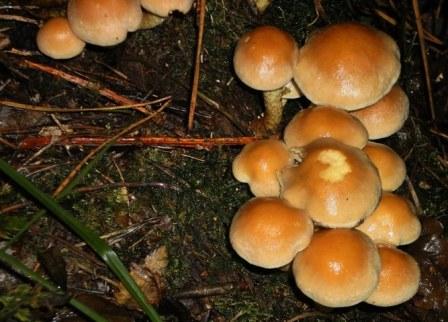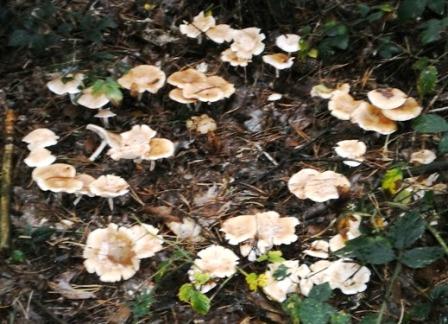A mushroom is the fruiting body of a fungus and is used for reproduction. The actual organism, the mycelium, consists of a large network of elongated wires, the hyphae. The whole of these wires (in soil, dead or living wood, manure, etc.) is called mycelium.
A mold is the same as a fungus but the name is usually used for the tiny, fluffy excesses on food. We call it mold when the mushrooms are to small to distinguish them with the naked eye.
 Experienced mycologists determine up to about 20% of the mushrooms on sight in the field. For other microscopic examination is necessary (particularly of spores).
Experienced mycologists determine up to about 20% of the mushrooms on sight in the field. For other microscopic examination is necessary (particularly of spores).
So don’t base your determination frivolously on a picture (in a book or on the Internet). Be sure to read the descriptions. Certainly not anyone who writes on the Internet is a connoisseur.
Never rely on just one book and sure not on older releases. (Where eg the Paxillus involutus, Brown Rollrim mushroom was 'edible', and now is cumulative toxic.)
Please note that young and old specimens may look very different than a typical mushroom.
Note also the determination of the area (wood) on which the fungus grows.
Never store them in sealed plastic boxes or close together in bags.
First identify them, then -maybe and moderate, pick some.
Doubtful cases: keep your hands off.
On the website of Jcdegids.be you find good pictures and accurately determinated mushrooms. http://www.jcdegids.be/Frameset-29a.html
Fungi reproduce both sexually (via spores) and asexually (by hyphae and mycelia). As saprophytes (decomposers) fungi play an important ecological role in the degradation of plant material. (Bacteria are especially important in the breakdown of animal material).
The science dealing with fungi is called mycology (from the Greek for fungus: mykes). Mushrooms are also called mycota.
The spores, and their color, fins and their shape, are important characteristics to identify species. The shape of the hat, the rim, the stem, the ring, color, smell... will all help.
 Most species produce millions, even billions of microscopic spores that are therefor very widespread. At this moment there are probably dozens of species for example in your nose.
Most species produce millions, even billions of microscopic spores that are therefor very widespread. At this moment there are probably dozens of species for example in your nose.
Each species is a specialist on a given product (e.g. pine) and breaks down in a particular environment under certain conditions. About this still very little is known. We cannot yet predict the years, as the weather, the days and places, where and when mushrooms can be found. Only approximate.
There are thousands of species of edible mushrooms. Knowing and recognizing them requires study and experience. Learn it by walking along with connoisseurs. Use for consumption only species that you identify with certainty. Don’t touch the rest. Always boil them wel, because some edible species are uncooked still toxic.
If you want to collecting mushroom in bush and field, keep in mind that about 10 species are deadly, and only 10 are tasty. Make sure that you recognize them, and know what you are doing. All other species are tiny, tasteless, vulgar and / or unhealthy.
Many of ourtastyand ediblemushrooms areboletus. Theyare alwayssolid.The stems too. The sporespass out throughtubes (holes).
A few of the most consumed mushrooms are:
The (button) mushroom (Agaricus bisporus, found in horse pastures.)
The oyster mushroom (Pleurotus ostreatus). In the wild they grow mostly on wood.
The morels (Ascomycetes) are mainly found in open scrub on wooded areas or bare ground, or ruins and gardens, in the late spring. Also under ash, elm and apple trees. Not to be confused with the poisonous false morels (Gyromitra esculenta).
Chanterelle (Cantharellus cibarius): easy edible mushroom.
The cep (Boletus edulis, penny bun, porcino) is known for its nutty flavor.
The sulfur fungus (Laetiporus sulphureus) has a slightly sour taste that some find resemble the taste of chicken. He is also called chicken of the wood (and sulphur shelf). Some people are allergic to it, so you have to test for yourself. He is i.a. breaded and used in soup. It grows on hardwood and is striking yellow (sulfur -colored) and large.
Eat the Shaggy Ink Cap, Lawyer's Wig or Shaggy Mane (Coprinus comatus) shortly after picking, because he soon turns into a kind of semi-liquid black ink. Only the fresh hats and stems are edible. One can pick them best while they’re young.
The Giant Puffball (Calvatia gigantea): white spherical fruit body that can store heavy metals. You can cut disks to eat or cover wounds. Popularly another name is false tinder. Dried you can use them to make fire. The smoke is impressive. They smoked the bees out with this fungus.
Mushrooms are usually specialized scavengers that thrive on one particular surface. Nettles grow in nitrogen-rich places. You will not find any mushrooms with nettles.
You can find mushrooms usually grouped together (in a circle ...). But while picking always leave one, not only for animals and insects that are living from it, but also to spread the spores.
1 gram of soil may contain 200 species of fungi and spores.
You can store dried mushrooms.
Tinder (Fomes fomentarius) is not edible but was widely used. First course as tinder: cut the mushroom in strings. Then gently knocking and cooking in lye. Allow to dry. This material is very flammable.
Bandage was done as follows: cut the hard outer, cut discs and knock them to become soft. It would work astringent and styptic.
From slices of Fomes they also made a kind of leather for gloves and bandages. The processed fiber provides a firm and soft product. In Hungary, there still would be made warm hats and caps.
‘You can eat all the mushrooms. Some only once.’
‘Life is too short to fill mushrooms.’(Shirley Conran)
